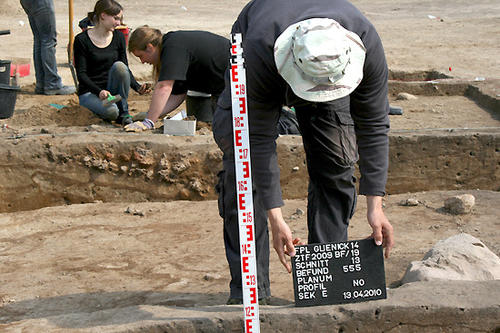Pre-Roman Iron Age: Slag, a Skeleton, and the Sun God
Archaeologists from Freie Universität Berlin study iron smelting in the Pre-Roman Iron Age at a site in southern Brandenburg
May 25, 2010
So far archaeologists from Freie Universität have been digging for more than six months in the area around Rangsdorf Lake.
Image Credit: Sabrina Wendling
The forest between the villages of Glienick and Gross-Schulzendorf is inhabited only by stalks of grain and little deer. Well, not the whole forest, actually: A team of archaeologists from Freie Universität have set up a tent there and begun digging up the ground. Layer by layer, the archaeologists, led by Markolf Brumlich, have dug back in time to a few hundred years before Asterix and Obelix – down to the pre-Roman Iron Age, which spanned from the 6th to the 1st century BC.
Markolf Brumlich holds a brown clump in his hand. It isn’t shiny, has no value in gold, and it isn’t jewelry or decoration, either – actually, it’s rough and rusty. But then Brumlich tells a centuries-old story: This clump is a piece of iron slag, left over after the process of iron production. Brumlich is in charge of the excavations being conducted by the Institute of Prehistoric Archaeology of Freie Universität. Together with a team of 15 students, he is studying iron smelting during the pre-Roman Iron Age in northern Central Europe, using the example of an ancient settlement to the south of Berlin, near Rangsdorf Lake and the village of Glienick. Archaeologists working at this site have found the oldest evidence of iron smelting in all of northern Central Europe.
The archaeologists have already filled more than 300 buckets with the brown clumps of iron slag – equivalent to five tons. “The slag is weighed, and based on that, we can calculate the total amount of iron produced at this settlement later on,” Brumlich says. The shape of the slag also tells archaeologists whether it stems from iron production or processing.
While the archaeologists are digging for iron slag, they are also finding completely different things in the process: the skeleton of a horse, for instance. The animal was skillfully arranged under the ground, with no signs of slaughtering for meat. “The horse was probably a sacrifice,” Brumlich says. “It lay buried right between holes filled with iron slag, so perhaps it was meant to bring luck to the iron production here.”
Other findings also yield insight into the religious beliefs of these Iron Age settlers: A potsherd shows the shape of a decoration similar to a wagon wheel. “The wagon wheel was most likely a symbol of the sun god, comparable to the Greek god Helios,” Brumlich says definitively. In the settlers’ belief system, the sun god drove the sun from east to west with a chariot – how else could the movement of the sun across the heavens be explained?
The archaeologists have been excavating the site near Rangsdorf Lake for more than six months – four days a week, ten hours a day. “Yes, it has been pretty challenging,” say archaeology students Eik Jagemann and Paul Fischer, “but it has also been fun.” They have done all of their work over the past few months standing, squatting, and kneeling, and now all that remains is to “wade in” in a figurative sense instead of a literal one: The objects they have found will be compared with those from other sources and soon, they will be used to write a new chapter in the history of iron.
Further Information
Markolf Brumlich, M.A.
Institute of Prehistoric Archaeology
Tel.: +49 (0)30 838-540 66
Email: brumlich@zedat.fu-berlin.de

